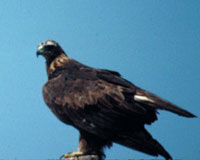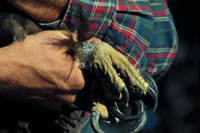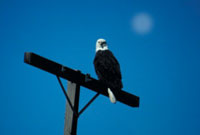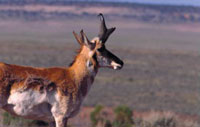For several seasons, I had the good fortune to slog through the mud and snow to overlooks along the Colorado River and watch two different pairs of bald eagles throughout their months-long breeding season. The work started in February and could last into June. The nests were not visible from the road; I had to hike about a mile to reach either viewpoint. Although the winter weather was cold but dry most of the time, there were days when walking through the Mancos Shale gumbo added an extra ten pounds of mud to my boots.
No matter. Upon reaching my vantagepoints, all was good. I’d unfold my Crazy Creek chair, set up my tripod and spotting scope, and watch the action. I was there to observe the breeding activities of the eagles, but I’d also keep track of the elk, deer, waterfowl, redtails, and other critters that I could see. In short, an ideal wildlife job.
When the eagles were incubating their eggs, things got slow. About every 90 minutes, the pair would switch at the nest. When one adult finished their shift, they would fly off to a nearby snag and have a good shake, then preen their feathers back into shape.
Once the young hatched in spring, my schedule went down to one visit per week until the young fledged in June. Or, some years the nests failed. I could ascertain this by the lack of activity around the nest. The adults did not fly in with prey or they were just gone. Nestling mortality, although disappointing, is as much of the process as success. But with only two active nests along the Colorado River in Utah, every nest failure had an impact.
Winter Eagles
Utah hosts about twenty-five percent of the wintering bald eagles west of the Rocky Mountains. That translates to over 1,200 birds, but the majority of them haunt the northern portion of the state. These “white-headed fish eaters” prey on fish, wounded waterfowl, carrion, and rabbits during their winter tenure. And in the southern portion of the state it may seem unusual to see a bald eagle standing out in the Cisco Desert along Interstate 70, but that is an ideal area for them to hunt.
On my drives to the two nest sites, I would often see balds along the River Road (UT 128), as well as balds and golden eagles perched on small hills dotting the Cisco Desert. Once I saw a couple of bald and golden eagles fighting over a jackrabbit carcass with a lone coyote. One bird would grab the rabbit and try to fly off only to be harassed by the others. Dropping the prey, another bird would try to snatch it and fly off with the meal. Meanwhile, the coyote kept pace along the ground, occasionally picking up the dropped rabbit and trying to make a dash for it. Undaunted, the eagles dove at the coyote until the rabbit was dropped. This kept on for a good twenty minutes until the circus moved over a small ridge and out of view. I never knew who won the rabbit tug-of-war.
Although bald eagles could be viewed in the Cisco Desert during the day, these birds roosted in cottonwood groves along the Colorado River. These sites provided cover and protection from the elements. You could tell it was the bald’s off-season, as birds of various ages roosted in close proximity to one another. Come the breeding season, this shared indifference would cease.
Golden eagles, on the other wing, don’t share this communal approach like the balds do. Although several birds may gather at a kill, you don’t see goldens roosting together like groups of bald eagles often will. But the Cisco Desert is a great place to watch for golden eagles as they prey mostly upon small mammals like jackrabbits, cottontails, prairie dogs and ground squirrels. Carrion is an easy winter meal, and a dead deer or pronghorn will attract a crowd.
So in your next wintry trip between Loma, Colorado and Green River, Utah, keep an eye out for these magnificent eagles, especially for the ones standing on the highway trying to scrape up some roadkill.
Bald Eagle Day
The Utah Division of Wildlife Resources will celebrate Bald Eagle Day on February 7 and 14 in northern Utah. Large numbers of bald eagles winter in and around the Great Salt Lake, Bear River and the numerous agricultural fields in the valleys. There isn’t an event in southeastern Utah, so you’ll just have to celebrate on your own for each eagle you see in the Moab area.





